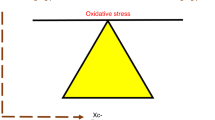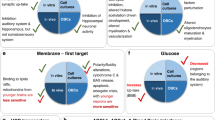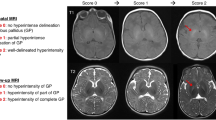Abstract
Despite the availability of successful prevention strategies to prevent excessive hyperbilirubinemia, the neurological sequelae of bilirubin neurotoxicity (BNTx) still occur throughout the world. Kernicterus, encephalopathy due to BNTx, is now understood to be a spectrum of severity and phenotypes known as kernicterus spectrum disorder (KSD). A better understanding of the selective neuropathology and molecular biology of BNTx and using consistent clinical definitions of KSDs as outcome measure can lead to more accurately predicting the risk and causes of BNTx and KSDs. In Part I of our two-part review, we will summarize current and recent advances in the understanding of the selective neuropathology and molecular biology of the disease. Herein we emphasize the role of unbound, free unconjugated bilirubin as well as genetic contributions to the susceptibility BNTx and the development of KSDs. In Part II, we focus on current and possible novel methods to prevent BNTx and ABE and treat ABE and KSDs.
Similar content being viewed by others
Log in or create a free account to read this content
Gain free access to this article, as well as selected content from this journal and more on nature.com
or
References
Management of hyperbilirubinemia in the newborn infant 35 or more weeks of gestation. Pediatrics 114, 297–316 (2004).
Maisels, M. J. et al. Hyperbilirubinemia in the newborn infant > or =35 weeks’ gestation: an update with clarifications. Pediatrics 124, 1193–1198 (2009).
Hsia, D. Y., Allen, F. H. Jr., Gellis, S. S. & Diamond, L. K. Erythroblastosis fetalis. VIII. Studies of serum bilirubin in relation to Kernicterus. N. Engl. J. Med. 247, 668–671 (1952).
Andersen, D. H., Blanc, W. A., Crozier, D. N. & Silverman, W. A. A difference in mortality rate and incidence of kernicterus among premature infants allotted to two prophylactic antibacterial regimens. Pediatrics 18, 614–625 (1956).
Odell, G. B. Studies in kernicterus. I. The protein binding of bilirubin. J. Clin. Invest. 38, 823–833 (1959).
Odell, G. B. The dissociation of bilirubin from albumin and its clinical implications. J. Pediatr. 55, 268–279 (1959).
Odell, G. B. Influence of pH on distribution of bilirubin between albumin and mitochondria. Proc. Soc. Exp. Biol. Med. 120, 352–354 (1965).
Odell, G. B. The distribution and toxicity of bilirubin. E. Mead Johnson address 1969. Pediatrics 46, 16–24 (1970).
Odell, G. B. Influence of binding on the toxicity of bilirubin. Ann. NY Acad. Sci. 226, 225–237 (1973).
Odell, G. B., Cohen, S. N. & Kelly, P. C. Studies in kernicterus. II. The determination of the saturation of serum albumin with bilirubin. J. Pediatr. 74, 214–230 (1969).
Diamond, I. & Schmid, R. Neonatal hyperbilirubinemia and kernicterus. Experimental support for treatment by exposure to visible light. Arch. Neurol. 18, 699–702 (1968).
Behrman, R. E. & Hsia, D. Y. Summary of a symposium on phototherapy for hyperbilirubinemia. J. Pediatr. 75, 718–726 (1969).
Radmacher, P. G. et al. A modified Bilirubin-induced neurologic dysfunction (BIND-M) algorithm is useful in evaluating severity of jaundice in a resource-limited setting. BMC Pediatr. 15, 28 (2015).
Amin, S. B. Clinical assessment of bilirubin-induced neurotoxicity in premature infants. Semin. Perinatol. 28, 340–347 (2004).
Bhutani, V. K. et al. Neonatal hyperbilirubinemia and Rhesus disease of the newborn: incidence and impairment estimates for 2010 at regional and global levels. Pediatr. Res. 74(Suppl 1), 86–100 (2013).
Olusanya, B. O., Ogunlesi, T. A. & Slusher, T. M. Why is kernicterus still a major cause of death and disability in low-income and middle-income countries? Arch. Dis. Child. 99, 1117–1121 (2014).
Slusher, T. M. et al. Burden of severe neonatal jaundice: a systematic review and meta-analysis. BMJ Paediatr. Open 1, e000105 (2017).
Sgro, M., Campbell, D. M., Kandasamy, S. & Shah, V. Incidence of chronic bilirubin encephalopathy in Canada, 2007-2008. Pediatrics 130, e886–e890 (2012).
Maisels, M. J. Neonatal hyperbilirubinemia and kernicterus - not gone but sometimes forgotten. Early Hum. Dev. 85, 727–732 (2009).
Shapiro, S. M. Chronic bilirubin encephalopathy: diagnosis and outcome. Semin. Fetal Neonatal Med. 15, 157–163 (2010).
Malamud, N. in Kernicterus and its Importance in Cerebral Palsy (ed. Swinyard, C. A.) 230–246 (Charles C. Thomas, Springfield, IL, 1961).
Ahdab-Barmada, M. Kernicterus in the premature neonate. J. Perinatol. 7, 149–152 (1987).
Ahdab-Barmada, M. & Moossy, J. The neuropathology of kernicterus in the premature neonate: diagnostic problems. J. Neuropathol. Exp. Neurol. 43, 45–56 (1984).
Conlee, J. W. & Shapiro, S. M. Morphological changes in the cochlear nucleus and nucleus of the trapezoid body in Gunn rat pups. Hear Res. 57, 23–30 (1991).
Shapiro, S. M. & Conlee, J. W. Brainstem auditory evoked potentials correlate with morphological changes in Gunn rat pups. Hear Res. 57, 16–22 (1991).
Conlee, J. W. & Shapiro, S. M. Development of cerebellar hypoplasia in jaundiced Gunn rats: a quantitative light microscopic analysis. Acta Neuropathol. 93, 450–460 (1997).
Conlee, J. W., Shapiro, S. M. & Churn, S. B. Expression of the alpha and beta subunits of Ca2+/calmodulin kinase II in the cerebellum of jaundiced Gunn rats during development: a quantitative light microscopic analysis. Acta Neuropathol. 99, 393–401 (2000).
Shaia, W. T. et al. Immunohistochemical localization of calcium-binding proteins in the brainstem vestibular nuclei of the jaundiced Gunn rat. Hear Res. 173, 82–90 (2002).
Spencer, R. F., Shaia, W. T., Gleason, A. T., Sismanis, A. & Shapiro, S. M. Changes in calcium-binding protein expression in the auditory brainstem nuclei of the jaundiced Gunn rat. Hear Res. 171, 129–141 (2002).
Shaia, W. T., Shapiro, S. M. & Spencer, R. F. The jaundiced gunn rat model of auditory neuropathy/dyssynchrony. Laryngoscope 115, 2167–2173 (2005).
Shapiro, S. M. Definition of the clinical spectrum of kernicterus and bilirubin-induced neurologic dysfunction (BIND). J. Perinatol. 25, 54–59 (2005).
Le Pichon, J. B., Riordan, S. M., Watchko, J. & Shapiro, S. M. The neurological sequelae of neonatal hyperbilirubinemia: definitions, diagnosis and treatment of the kernicterus spectrum disorders (KSDs). Curr. Pediatr. Rev. 13, 199–209 (2017).
Shapiro, S. M. & Popelka, G. R. Auditory impairment in infants at risk for bilirubin-induced neurologic dysfunction. Semin. Perinatol. 35, 162–170 (2011).
Ye, H. et al. Bilirubin-induced neurotoxic and ototoxic effects in rat cochlear and vestibular organotypic cultures. Neurotoxicology 71, 75–86 (2019).
Yilmaz, Y. et al. Magnetic resonance imaging findings in patients with severe neonatal indirect hyperbilirubinemia. J. Child Neurol. 16, 452–455 (2001).
Shapiro, S. M., Bhutani, V. K. & Johnson, L. Hyperbilirubinemia and kernicterus. Clin. Perinatol. 33, 387–410 (2006).
Hachiya, Y. & Hayashi, M. Bilirubin encephalopathy: a study of neuronal subpopulations and neurodegenerative mechanisms in 12 autopsy cases. Brain Dev. 30, 269–278 (2008).
Johnston, M. V. & Hoon, A. H. Jr. Possible mechanisms in infants for selective basal ganglia damage from asphyxia, kernicterus, or mitochondrial encephalopathies. J. Child Neurol. 15, 588–591 (2000).
Hegeman, D. J., Hong, E. S., Hernández, V. M. & Chan, C. S. The external globus pallidus: progress and perspectives. Eur. J. Neurosci. 43, 1239–1265 (2016).
Kita, H. Parvalbumin-immunopositive neurons in rat globus pallidus: a light and electron microscopic study. Brain Res. 657, 31–41 (1994).
Mallet, N. et al. Dichotomous organization of the external globus pallidus. Neuron 74, 1075–1086 (2012).
Nobrega-Pereira, S. et al. Origin and molecular specification of globus pallidus neurons. J. Neurosci. 30, 2824–2834 (2010).
Hernandez, V. M. et al. Parvalbumin+ neurons and Npas1+ neurons are distinct neuron classes in the mouse external globus pallidus. J. Neurosci. 35, 11830–11847 (2015).
Bortolussi, G. & Muro, A. F. Experimental models assessing bilirubin neurotoxicity. Pediatr. Res. https://doi.org/10.1038/s41390-019-0570-x (2019).
Dal Ben, M., Bottin, C., Zanconati, F., Tiribelli, C. & Gazzin, S. Evaluation of region selective bilirubin-induced brain damage as a basis for a pharmacological treatment. Sci. Rep. 7, 41032 (2017).
Wennberg, R. P., Ahlfors, C. E., Bhutani, V. K., Johnson, L. H. & Shapiro, S. M. Toward understanding kernicterus: a challenge to improve the management of jaundiced newborns. Pediatrics 117, 474–485 (2006).
Ahlfors, C. E., Wennberg, R. P., Ostrow, J. D. & Tiribelli, C. Unbound (free) bilirubin: improving the paradigm for evaluating neonatal jaundice. Clin. Chem. 55, 1288–1299 (2009).
Ostrow, J. D., Pascolo, L. & Tiribelli, C. Reassessment of the unbound concentrations of unconjugated bilirubin in relation to neurotoxicity in vitro. Pediatr. Res. 54, 98–104 (2003).
Gazzin, S. et al. Bilirubin accumulation and Cyp mRNA expression in selected brain regions of jaundiced Gunn rat pups. Pediatr. Res. 71, 653–660 (2012).
Claireaux, A. E., Cole, P. G. & Lathe, G. H. Icterus of the brain in the newborn. Lancet 265, 1226–1230 (1953).
Shapiro, S. M., Sombati, S., Geiger, A. & Rice, A. C. NMDA channel antagonist MK-801 does not protect against bilirubin neurotoxicity. Neonatology 92, 248–257 (2007).
Keino, H. & Kashiwamata, S. Critical period of bilirubin-induced cerebellar hypoplasia in a new Sprague-Dawley strain of jaundiced Gunn rats. Neurosci. Res. 6, 209–215 (1989).
Amin, S. B. & Wang, H. Bilirubin albumin binding and unbound unconjugated hyperbilirubinemia in premature infants. J. Pediatr. 192, 47–52 (2018).
Amin, S. B. & Wang, H. Unbound unconjugated hyperbilirubinemia is associated with central apnea in premature infants. J. Pediatr. 166, 571–575 (2015).
Watchko, J. F. & Lin, Z. in Care of the Jaundiced Neonate (eds Stevenson, D., Maisels, M. J. & Watchko, J. F.) 1–27 (McGraw Hill Professional, 2012).
Johnson, A. D. et al. Genome-wide association meta-analysis for total serum bilirubin levels. Hum. Mol. Genet. 18, 2700–2710 (2009).
Watchko, J. F. & Lin, Z. Exploring the genetic architecture of neonatal hyperbilirubinemia. Semin. Fetal Neonatal Med. 15, 169–175 (2010).
Brites, D. The evolving landscape of neurotoxicity by unconjugated bilirubin: role of glial cells and inflammation. Front. Pharm. 3, 88 (2012).
Fernandes, A., Falcão, A. S., Silva, R. F. M., Brito, M. A. & Brites, D. MAPKs are key players in mediating cytokine release and cell death induced by unconjugated bilirubin in cultured rat cortical astrocytes. Eur. J. Neurosci. 25, 1058–1068 (2007).
Fernandes, A. et al. Inflammatory signalling pathways involved in astroglial activation by unconjugated bilirubin. J. Neurochem. 96, 1667–1679 (2006).
Fernandes, A., Silva, R. F., Falcao, A. S., Brito, M. A. & Brites, D. Cytokine production, glutamate release and cell death in rat cultured astrocytes treated with unconjugated bilirubin and LPS. J. Neuroimmunol. 153, 64–75 (2004).
Barateiro, A. et al. Unconjugated bilirubin restricts oligodendrocyte differentiation and axonal myelination. Mol. Neurobiol. 47, 632–644 (2013).
Barateiro, A., Vaz, A. R., Silva, S. L., Fernandes, A. & Brites, D. ER stress, mitochondrial dysfunction and calpain/JNK activation are involved in oligodendrocyte precursor cell death by unconjugated bilirubin. Neuromolecular Med. 14, 285–302 (2012).
Riordan, S. M. et al. A hypothesis for using pathway genetic load analysis for understanding complex outcomes in bilirubin encephalopathy. Front. Neurosci. 10, 376 (2016).
Acknowledgements
This study was supported by startup funds provided by Children’s Mercy Hospital Department of Pediatrics.
Author information
Authors and Affiliations
Contributions
Both authors drafted and critically edited the manuscript together and gave final approval of the version to be published.
Corresponding author
Ethics declarations
Competing interests
The authors declare no competing interests.
Additional information
Publisher’s note Springer Nature remains neutral with regard to jurisdictional claims in published maps and institutional affiliations.
Rights and permissions
About this article
Cite this article
Riordan, S.M., Shapiro, S.M. Review of bilirubin neurotoxicity I: molecular biology and neuropathology of disease. Pediatr Res 87, 327–331 (2020). https://doi.org/10.1038/s41390-019-0608-0
Received:
Revised:
Accepted:
Published:
Issue date:
DOI: https://doi.org/10.1038/s41390-019-0608-0
This article is cited by
-
In situ growth of luminescent d-f MOF nanostructures on bacterial cellulose as an accessible kit for early jaundice diagnosis
Scientific Reports (2025)
-
Molecular events in brain bilirubin toxicity revisited
Pediatric Research (2024)
-
Neonatal phototherapy and risk of epilepsy—A Danish population based study
European Journal of Pediatrics (2024)
-
Bilirubin Encephalopathy
Current Neurology and Neuroscience Reports (2022)
-
5 Tage altes Neugeborenes mit „Gelbsucht“
Monatsschrift Kinderheilkunde (2022)



